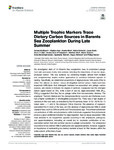Multiple Trophic Markers Trace Dietary Carbon Sources in Barents Sea Zooplankton During Late Summer
| dc.contributor.author | Kohlbach, D | |
| dc.contributor.author | Hop, H | |
| dc.contributor.author | Wold, A | |
| dc.contributor.author | Schmidt, K | |
| dc.contributor.author | Smik, L | |
| dc.contributor.author | Belt, Simon | |
| dc.contributor.author | Keck Al-Habahbeh, A | |
| dc.contributor.author | Woll, M | |
| dc.contributor.author | Graeve, M | |
| dc.contributor.author | Dąbrowska, AM | |
| dc.contributor.author | Tatarek, A | |
| dc.contributor.author | Atkinson, A | |
| dc.contributor.author | Assmy, P | |
| dc.date.accessioned | 2021-01-18T14:49:56Z | |
| dc.date.available | 2021-01-18T14:49:56Z | |
| dc.date.issued | 2021-01-14 | |
| dc.identifier.issn | 2296-7745 | |
| dc.identifier.issn | 2296-7745 | |
| dc.identifier.other | 610248 | |
| dc.identifier.uri | http://hdl.handle.net/10026.1/16807 | |
| dc.description.abstract |
<jats:p>We investigated diets of 24 Barents Sea zooplankton taxa to understand pelagic food-web processes during late summer, including the importance of sea ice algae-produced carbon. This was achieved by combining insights derived from multiple and complementary trophic marker approaches to construct individual aspects of feeding. Specifically, we determined proportions of algal-produced fatty acids (FAs) to reflect the reliance on diatom- versus dinoflagellate-derived carbon, highly branched isoprenoid (HBI) lipids that distinguish between ice-associated and pelagic carbon sources, and sterols to indicate the degree of carnivory. Copepods had the strongest diatom signal based on FAs, while a lack of sea ice algae-associated HBIs (IP<jats:sub>25</jats:sub>, IPSO<jats:sub>25</jats:sub>) suggested that they fed on pelagic rather than ice-associated diatoms. The amphipod <jats:italic>Themisto libellula</jats:italic> and the ctenophores <jats:italic>Beroë cucumis</jats:italic> and <jats:italic>Mertensia ovum</jats:italic> had a higher contribution of dinoflagellate-produced FAs. There was a high degree of carnivory in this food web, as indicated by the FA carnivory index 18:1(<jats:italic>n</jats:italic>−9)/18:1(<jats:italic>n</jats:italic>−7) (mean value &lt; 1 only in the pteropod <jats:italic>Clione limacina</jats:italic>), the presence of copepod-associated FAs in most of the taxa, and the absence of algal-produced HBIs in small copepod taxa, such as <jats:italic>Oithona similis</jats:italic> and <jats:italic>Pseudocalanus</jats:italic> spp. The coherence between concentrations of HBIs and phytosterols within individuals suggested that phytosterols provide a good additional indication for algal ingestion. Sea ice algae-associated HBIs were detected in six zooplankton species (occurring in krill, amphipods, pteropods, and appendicularians), indicating an overall low to moderate contribution of ice-associated carbon from late-summer sea ice to pelagic consumption. The unexpected occurrence of ice-derived HBIs in pteropods and appendicularians, however, suggests an importance of sedimenting ice-derived material at least for filter feeders within the water column at this time of year.</jats:p> | |
| dc.format.extent | 0-0 | |
| dc.language.iso | en | |
| dc.publisher | Frontiers Media SA | |
| dc.subject | food web | |
| dc.subject | Barents Sea | |
| dc.subject | sea ice | |
| dc.subject | carbon sources | |
| dc.subject | trophic markers | |
| dc.subject | fatty acids | |
| dc.subject | highly branched isoprenoid (HBI) lipids | |
| dc.subject | sterols | |
| dc.title | Multiple Trophic Markers Trace Dietary Carbon Sources in Barents Sea Zooplankton During Late Summer | |
| dc.type | journal-article | |
| dc.type | Journal Article | |
| plymouth.author-url | https://www.webofscience.com/api/gateway?GWVersion=2&SrcApp=PARTNER_APP&SrcAuth=LinksAMR&KeyUT=WOS:000611108800005&DestLinkType=FullRecord&DestApp=ALL_WOS&UsrCustomerID=11bb513d99f797142bcfeffcc58ea008 | |
| plymouth.issue | 0 | |
| plymouth.volume | 7 | |
| plymouth.publication-status | Published online | |
| plymouth.journal | Frontiers in Marine Science | |
| dc.identifier.doi | 10.3389/fmars.2020.610248 | |
| plymouth.organisational-group | /Plymouth | |
| plymouth.organisational-group | /Plymouth/Faculty of Science and Engineering | |
| plymouth.organisational-group | /Plymouth/Faculty of Science and Engineering/School of Geography, Earth and Environmental Sciences | |
| plymouth.organisational-group | /Plymouth/REF 2021 Researchers by UoA | |
| plymouth.organisational-group | /Plymouth/REF 2021 Researchers by UoA/UoA07 Earth Systems and Environmental Sciences | |
| plymouth.organisational-group | /Plymouth/Research Groups | |
| plymouth.organisational-group | /Plymouth/Research Groups/Marine Institute | |
| plymouth.organisational-group | /Plymouth/Users by role | |
| plymouth.organisational-group | /Plymouth/Users by role/Academics | |
| plymouth.organisational-group | /Plymouth/Users by role/Researchers in ResearchFish submission | |
| dcterms.dateAccepted | 2020-01-17 | |
| dc.rights.embargodate | 2021-1-21 | |
| dc.identifier.eissn | 2296-7745 | |
| dc.rights.embargoperiod | Not known | |
| rioxxterms.funder | Natural Environment Research Council | |
| rioxxterms.identifier.project | Quantifying the contribution of sympagic versus pelagic diatoms to Arctic food webs and biogeochemical fluxes (SYM-PEL) | |
| rioxxterms.versionofrecord | 10.3389/fmars.2020.610248 | |
| rioxxterms.licenseref.uri | http://www.rioxx.net/licenses/all-rights-reserved | |
| rioxxterms.licenseref.startdate | 2021-01-14 | |
| rioxxterms.type | Journal Article/Review | |
| plymouth.funder | Quantifying the contribution of sympagic versus pelagic diatoms to Arctic food webs and biogeochemical fluxes (SYM-PEL)::Natural Environment Research Council |


